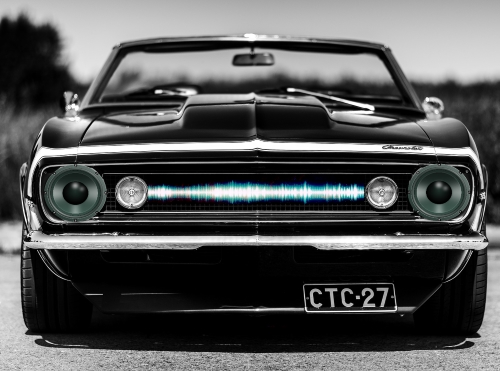Vintage muscle cars now commonly sell for $30,000. What the heck is going on? I mean, come on – those cars were never truly “great,” were they?
I suppose it’s a subjective matter, with some nostalgia thrown in for good measure. Now that the teenagers of the 1960s are middle-aged folks with disposable income, they’re fueling a demand that seems, well, largely unfounded.
But that’s how value works, doesn’t it? Supply and demand. There are relatively few of those cars remaining, particularly in “showroom” condition, and those who want them have deep pockets. But compared to today’s models, they’re unreliable, unsafe, inefficient and difficult to maintain due to parts scarcity. So what’s the appeal?
Vintage audio equipment can be viewed in much of the same light. Modern gear is more compact, more efficient, more cost effective, lighter, and with more channels, more DSP and more blinking lights. But what about sound quality? That’s where it gets interesting.
Let’s return to cars for a second. Vintage muscle models did have certain “features” that can’t be found on today’s machines. Among those is their sound – the V8 rumble of a 442 that can’t be easily (or cheaply) reproduced today. And there’s an emotional aspect of the “old school” to that sound that grabs people.
Another factor is relatively easy servicing. I remember helping my dad work on the family’s 1970 Pontiac Firebird with a V8 (350) and Muncie 3-speed manual transmission. It was so sparse under the hood that you could nearly stand in the engine compartment without removing anything. Think about trying that with a modern model.
And just recently, I worked with my father to fix his vintage 1978 Dual turntable. Even though the mechanical design was complex (ever looked under the hood of one of those?), the electronics were simple. The power supply had quit and it turned out to be the usual suspect – a dead electrolytic capacitor. With a new one soldered in and a few minutes of re-assembly, we were listening to LPs again in no time
Older audio equipment can indeed be relatively simple to maintain due to the “through-hole” nature of the circuit board construction. Discrete parts can be changed out and modifications are easy to make. But what do you do if your modern 32-channel DSP/FPGA-based mixer goes down. Is it the firmware? The hardware? The power supply? A microcontroller?
In the manufacturing world, we both marvel and cringe when we see the sand-grain sized electronic components that populate the surface mount circuit boards inside things like miniature wireless system transmitters. To imagine repairing these by hand with a soldering iron is nearly inconceivable.
The Other Hand
So perhaps we’ve lost something over the past few decades. But what have we gained? The vast majority of audio equipment being designed and made today is far better than that of 20 years ago. No question.
Of course, many of us fondly remember our favorite mic preamps, compressors, and so on. And it can be argued that these things can’t be replaced by plugins and DSP magic. But from my perspective, equipment is better sounding, more reliable and easier to use by an order of magnitude.
Take power amplifiers. They used to be Class A/B monsters with huge transformers and giant capacitors. And they got really hot. Today’s amps are lighter, smaller, far more powerful, many times more efficient, and in many cases, incorporate at least rudimentary DSP.
I used to dream of having a delay on every channel with 1-millisecond resolution. Now it’s a reality and then some. In the past, when we wanted to update the FX rack, it involved adding and/or replacing physical units, with a good amount of hand-on wiring required. This is still done today, of course, but think of the amazing flexibility at our fingertips with digital consoles.
Add in digital networked audio, such as Audinate Dante and others, and we can move audio around in high-quality, low-latency digital format and drop it anywhere on the network with no additional loss.
Better Or Worse
But can there be too much of a good thing? The phrase “mission creep” applies. With the advent of 24-track tape machines, soon most of us were using all 24 tracks. And when we could tie two machines together, we began using 48 tracks. The over-use of readily available effects and plugins in both the studio world and in live sound is a very real problem.
So do all of these channels, plentiful DSP, ease of signal routing, immense amplifier power, and super-efficient loudspeakers automatically bring about better sound? Hardly. It can even be argued that the ease of access to all of this “stuff” has made things worse. How can that be?
Equipment and systems are more complicated. There’s a much steeper learning curve, and further, figuring out the operational parameters of that snazzy DSP doesn’t necessarily translate into better application of its capabilities. There also might now be too much reliance on technology at the expense of fundamental best practices. And frankly, modern equipment allows those who really don’t know what they’re doing to “get by.”
Still, I maintain that the best sounding shows of today are better than they’ve ever been. The majority in our industry are indeed making much of today’s gear, pushing the boundaries of what’s possible in live sound.
Future Scope
So where does it go from here? There is a huge responsibility on the shoulders of equipment designers and manufacturers. What users need most is clean, clear interface design. Products and systems must be easy to use despite their complexity. And conventions must be followed, to a point.
While we don’t necessarily have to have a console surface design that “looks like it always has,” we do need to name things in a consistent fashion, and further, move to standardize aspects like input and output levels. Nomenclature should make sense and aid in the intuitive operation of these systems.
Users also must strive to stay abreast of current technologies, products and procedures. Things do change. It’s no longer acceptable to expect everyone to keep doing things our way if we’re still spouting lines like “I’ve been doing it this way for 30 years.”
With that type of thinking, we’d all still be driving gas guzzlers that only go fast in a straight line as long as the plugs and points have been serviced. And I don’t think any of us want that.















